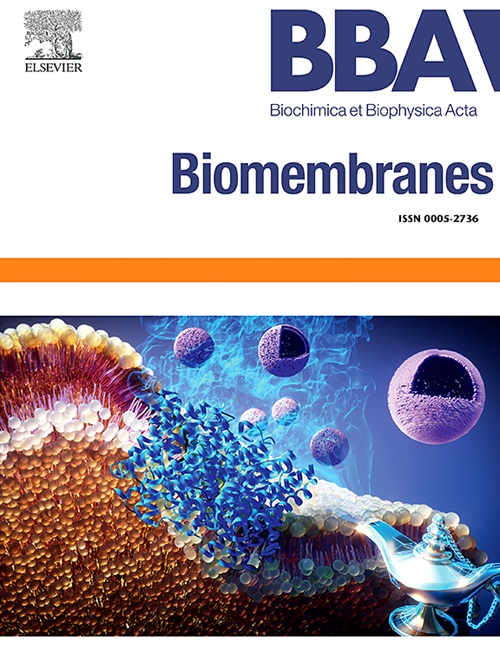Interactions of hinokitiol with fungal membrane lipids in model systems
IF 2.5
3区 生物学
Q3 BIOCHEMISTRY & MOLECULAR BIOLOGY
引用次数: 0
Abstract
Hinokitiol (β-thujaplicin) is a naturally occurring substance of antimicrobial properties, which can be used e.g. as a cosmetic preservative. In this work the influence of hinokitiol on the monolayers and bilayers formed from fungal membrane lipids (1-palmitoyl-2-oleoyl-sn-glycero-3-phosphoethanolamine – POPE; 1-palmitoyl-2-oleoyl-sn-glycero-3-phosphocholine – POPC and ergosterol) was investigated. These studies aimed to investigate the effect of hinokitiol on fungal membranes, being indicated as a target for this compound. In this context, the affinity of hinokitiol for ergosterol-containing membranes was of particular interest. The in vitro antifungal activity of hinokitiol was also determined. The results showed that hinokitiol is active against the Candida species tested and exhibits stronger antifungal than antibacterial activity. Moreover, hinokitiol alters the properties of model membranes and the observed effects correlated with ergosterol content in the system. Namely, the higher the ergosterol content, the greater the fluidizing and destabilising effect of hinokitiol and its removal from the model. Moreover, hinokitiol is not able to penetrate into ergosterol membranes; instead, causes strong destabilization of the film and dragging the monolayer material into the subphase. Thus, hinokitiol changes properties of model membrane by the exclusion of the molecules from the interface. The results evidenced differences in the interactions of hinokitiol with ergosterol vs phospholipids, and the interactions of hinokitiol with the membrane depend on the presence and levels of ergosterol. Thus, ergosterol can be a molecular target for this compound. Moreover, the presence of ergosterol in fungal membranes and its lack in bacteria membranes may explain stronger antifungal vs antibacterial effect of hinokitiol.

模型系统中扁柏酚与真菌膜脂的相互作用
扁柏醇是一种天然存在的具有抗菌特性的物质,可以用作化妆品防腐剂等。本文研究了扁柏醇对真菌膜脂(1-棕榈酰-2-油酰- n-甘油-3-磷酸乙醇胺- POPE)形成的单分子和双分子膜的影响;研究了1-棕榈酰-2-油酰-sn-甘油-3-磷脂胆碱- POPC和麦角甾醇。这些研究旨在研究桧木醇对真菌膜的影响,被认为是该化合物的靶点。在这种情况下,扁柏醇对麦角甾醇膜的亲和力是特别感兴趣的。测定了桧木醇的体外抗真菌活性。结果表明,桧木醇对所测念珠菌具有较强的抗真菌活性。此外,扁柏醇改变了模型膜的性质,所观察到的影响与系统中麦角甾醇的含量有关。也就是说,麦角甾醇含量越高,扁桃木醇的流化和不稳定作用越大,并从模型中去除它。此外,扁柏醇不能渗透到麦角甾醇膜中;相反,它会引起薄膜的强烈不稳定,并将单层材料拖入亚相。因此,扁柏醇通过从界面中排除分子来改变模型膜的性质。结果证明,在与麦角甾醇和磷脂的相互作用的差异,以及与膜的相互作用,仰赖麦角甾醇的存在和水平。因此,麦角甾醇可以作为该化合物的分子靶标。此外,真菌膜中麦角甾醇的存在和细菌膜中麦角甾醇的缺乏可能解释了桧木醇具有较强的抗真菌和抗菌作用。
本文章由计算机程序翻译,如有差异,请以英文原文为准。
求助全文
约1分钟内获得全文
求助全文
来源期刊

Biochimica et biophysica acta. Biomembranes
生物-生化与分子生物学
CiteScore
8.20
自引率
5.90%
发文量
175
审稿时长
2.3 months
期刊介绍:
BBA Biomembranes has its main focus on membrane structure, function and biomolecular organization, membrane proteins, receptors, channels and anchors, fluidity and composition, model membranes and liposomes, membrane surface studies and ligand interactions, transport studies, and membrane dynamics.
 求助内容:
求助内容: 应助结果提醒方式:
应助结果提醒方式:


